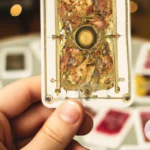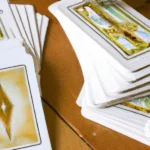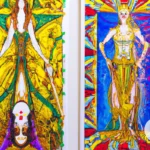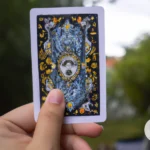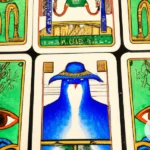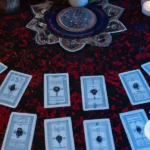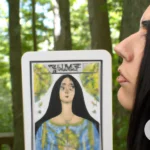As humans, we are drawn to symbols and imagery in a way that goes beyond words. They have the power to communicate complex ideas and emotions in an instant, bypassing the need for language altogether. For those who practice divination, tarot cards serve as a powerful tool for accessing the subconscious mind and tapping into intuitive wisdom. One deck that has gained popularity in recent years for its stunning iconography is the Gilded Tarot Deck. But how do we interpret and work with the symbols on these cards? In this article, we’ll explore the history and anatomy of the Gilded Tarot Deck, delve into the symbolism of both the major and minor arcana cards, and offer practical tips for incorporating this rich imagery into your tarot practice.
What is the Gilded Tarot Deck?
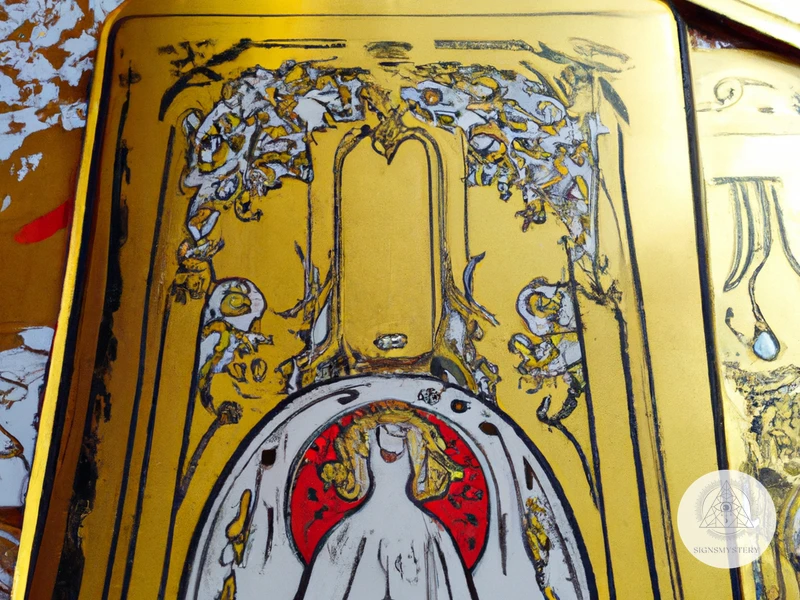
The Gilded Tarot Deck is a popular divination tool for those who practice tarot readings. The deck was created by Ciro Marchetti and first published in 2004. It features 78 cards with beautiful, intricate designs, and is known for its vivid colors and stunning artwork. The cards are designed to evoke a sense of nostalgia while still being accessible to modern tarot readers.
The Gilded Tarot Deck was created by digital artist Ciro Marchetti. Marchetti was born in Italy and later moved to the United States. He began his career as a graphic designer, but then decided to focus on his passion for creating digital artworks. He is known for his ability to blend traditional art techniques with modern technology.
The Gilded Tarot Deck is Marchetti’s most well-known project. He designed the deck to be visually rich, with intricate designs that capture the essence of each card. Rather than using traditional oil painting techniques, Marchetti worked entirely on a digital platform, allowing him to refine every detail of the deck.
The Gilded Tarot Deck consists of 78 cards, split into major and minor arcana. The major arcana consists of 22 cards that represent major life events and archetypes, such as The Fool, The Magician, and The Lovers. The minor arcana is split into four suits – cups, swords, pentacles, and wands – each containing 14 cards that represent the different elements and energies that make up our lives.
The cards themselves are a standard tarot size, measuring 2.75″ x 4.75″. They are printed on high-quality, glossy cardstock and feature a glossy gold gilding on the edges. The card backs feature a simple design of intricate golden patterns that make it easy to distinguish the front from the back.
The Gilded Tarot Deck is a stunning work of art that captures the essence of tarot readings while still being visually appealing. It’s no wonder that it has become a popular choice for those who practice tarot and seek self-reflection and growth. If you’re interested in learning more about the Gilded Tarot Deck, check out some of our other articles linked below.
The History behind the Gilded Tarot Deck
The origin of the Gilded Tarot Deck is quite fascinating and it sheds a lot of light on the deck’s unique symbolism. Learning about the history of the deck can give us a deeper understanding and appreciation for its imagery. The Gilded Tarot Deck was first produced by artist Ciro Marchetti in 2004, and it quickly gained popularity among Tarot enthusiasts for its breathtaking artwork and vivid colors. The deck is a re-imagining of the traditional Rider-Waite-Smith tarot deck but features several unique touches that make it stand out from other decks. In this section, we will explore the history of the Gilded Tarot Deck and how it came to be.
The Anatomy of the Gilded Tarot Deck
The Gilded Tarot Deck follows the structure of a traditional Tarot deck, consisting of 78 cards in total. The deck is divided into two Arcanas, the Major and Minor Arcana. The Major Arcana cards represent major life events, while the Minor Arcana cards represent the daily struggles and triumphs of everyday life.
The Major Arcana contains 22 cards, each depicting a different archetype or stage in a person’s spiritual journey. Each card has its name written prominently at the top of the card, accompanied by a Roman numeral. The Major Arcana cards are rich in symbolism and are often associated with significant life-changing events.
The Minor Arcana is divided into four suits, each representing one of the elements: earth, air, fire, and water. Each suit contains 14 cards, with ten numbered cards and four court cards. The court cards include the Page, Knight, Queen, and King, each representing a different personality or energy associated with that suit. The numbered cards show different scenarios and situations related to the element and nature of the suit.
The cards themselves are made from high-quality cardstock and feature intricate artwork with gold gilding. The artwork on the cards is rich in symbolism, with each card featuring different elements that are meaningful in Tarot divination.
The structure and design of the Gilded Tarot Deck offer a beautiful and effective tool for divination and self-reflection.
Interpreting the Symbolism on the Cards
As you begin to work with the Gilded Tarot Deck, interpreting the symbolism on the cards can be both exciting and daunting. Each card is rich in visual cues and archetypal imagery that can offer deep insight and guidance. Understanding the symbols on the cards is crucial in unlocking their messages and meaning for your practice. Whether you’re just starting out or have been working with the deck for some time, delving deeper into the symbolism on the cards can enhance your readings and provide a greater understanding of yourself and the world around you. In this section, we will explore the major and minor arcana cards and their symbols, providing you with the knowledge and tools to interpret them in your practice. For more information on the history and anatomy of the Gilded Tarot Deck, check out our article on the subject.
The Major Arcana Cards
The Major Arcana Cards in the Gilded Tarot Deck represent significant archetypes and life events. Understanding the symbolism in these cards can greatly enhance your Tarot practice. Below are the explanations of some of the most significant Major Arcana cards:
- The Fool: The Fool represents new beginnings, innocence, and taking risks. In the Gilded Tarot Deck, The Fool is depicted as a young man carrying a staff and a sack. He is gazing up at the sky, ready to embark on his journey.
- The Magician: The Magician symbolizes manifestation, action, and power. He is depicted holding a wand and controlling the four elements. The Magician card in the Gilded Tarot Deck shows a man harnessing the power of the universe to achieve his goals.
- The High Priestess: The High Priestess represents intuition, mysticism, and spiritual growth. She is depicted as a wise woman who holds the secrets of the universe. The card in the Gilded Tarot Deck shows her sitting on a throne, holding a scroll and a book.
- The Empress: The Empress represents abundance, fertility, and nurturing. She is depicted as a regal woman sitting on a throne with a crown of stars. The card in the Gilded Tarot Deck shows her holding a scepter and surrounded by nature.
- The Emperor: The Emperor symbolizes authority, structure, and fatherly guidance. He is depicted as a strong and powerful ruler who brings order to chaos. The card in the Gilded Tarot Deck shows him holding a scepter and a globe.
Understanding the meanings behind these Major Arcana cards can provide valuable insight into your own life journey. If you want to explore these cards in more detail, follow the link to Gilded Tarot Major Arcana Explore article.
The Minor Arcana Cards
The Minor Arcana Cards represent the everyday situations and experiences that we face in life. This part of the deck is divided into four suits: Swords, Cups, Wands, and Pentacles. Each of these suits is associated with a different element and represents a different aspect of our lives.
The Swords suit is associated with the element of Air and represents the mind and intellect. It deals with challenges related to decision-making, communication, and conflict. The Swords cards can be difficult to work with as they often depict painful and uncomfortable situations, but they also offer opportunities for growth and self-reflection. For example, the Three of Swords represents heartbreak and emotional pain, while the Ten of Swords symbolizes the end of a difficult situation or a painful realization.
The Cups suit is associated with the element of Water and represents emotions, relationships, and creativity. The Cups cards can be both uplifting and difficult, as they reflect the highs and lows of our emotional lives. The Ace of Cups symbolizes new beginnings, while the Three of Cups shows celebration and joy. The difficult cards in this suit can be challenging to interpret but offer opportunities for inner growth and healing.
The Wands suit is associated with the element of Fire and represents passion, creativity, and growth. The Wands cards often depict energy, action, and movement. They can be highly motivational and encourage us to take action in our lives. The Four of Wands symbolizes celebration and harmony, while the Ten of Wands represents a time of hard work and effort paying off.
The Pentacles suit is associated with the element of Earth and represents material possessions, finances, and stability. The Pentacles cards deal with practical matters such as work, money, and health. They can be very grounding and offer guidance on how to navigate the material world. The Ace of Pentacles represents a new financial or material opportunity, while the Ten of Pentacles depicts abundance and stability.
Incorporating the Minor Arcana cards into your tarot readings can provide a deeper understanding of the situation you are facing. By recognizing the symbolism of each card, you can gain insight into the challenges and opportunities that lie ahead. To learn more about how to work with the Gilded Tarot Deck, check out the Beginner’s Guide to the Gilded Tarot.
How to Work with the Symbols in Your Practice
Working with the symbols in your practice can deepen your understanding of the Gilded Tarot deck and enhance the guidance you receive from your readings. Each card is full of intricate imagery and hidden meanings that can provide insight into your own life journey. By incorporating symbolism into your practice, you can bring a new level of depth and meaning to your tarot readings. Whether you use the Gilded Tarot for self-reflection, growth, relationship advice, or any other purpose, understanding how to work with the symbols is essential. Let’s explore some techniques for using symbolism in your practice.
Incorporating Symbolism into Your Spreads
Incorporating symbolism into your tarot spreads is an excellent way to enhance the meaning and deepen your understanding of the cards. Whether you’re doing a simple three-card spread or an elaborate Celtic Cross spread, adding symbolism can provide valuable insights into your reading.
One way to incorporate symbolism is to choose a specific symbol that you want to focus on for your spread. For example, you might choose the moon card from the Major Arcana and decide to include it in each position of your spread.
Subscribe to Our Newsletter
Sign up to receive the latest news and updates.
Another approach is to use a symbolic system to create your spread. For example, you might use the elements (fire, air, earth, water) or the cardinal directions (north, south, east, west) to assign meanings to each position in your spread. This can help you connect with the energy of the symbols and tap into their deeper meanings.
Additionally, you can incorporate symbolism by choosing a themed spread that relates to a specific issue or question. For example, you might create a spread focused on self-reflection and growth that uses cards from the Major Arcana to explore different aspects of your personality and psyche. Alternatively, you might use the court cards from the Minor Arcana to create a relationship advice spread that focuses on communication, trust, and intimacy.
No matter how you choose to incorporate symbolism into your tarot spreads, remember that the symbols are simply tools to help you access your intuition and connect with the wisdom of the cards. Don’t be afraid to experiment with different approaches and see what works best for you and your practice.
To learn more about the symbolism in the Gilded Tarot deck, check out our articles on the Minor Arcana, cleansing your deck, and comparing the Gilded Tarot to other decks. You can also find tips on choosing a spread to work with the Gilded Tarot.
Meditating on Specific Symbols
One way to deepen your understanding of the Gilded Tarot deck is to meditate on specific symbols present in the cards. By meditating on these symbols, you can gain insight into their meaning and how they apply to your life.
To begin, choose a card from the deck that resonates with you. You may choose a card that you feel drawn to or one that you are curious about. Take the card and sit with it in a quiet, comfortable space where you won’t be disturbed.
Look at the image on the card and focus on one specific symbol that stands out to you. This may be a symbol that you have a personal connection to or one that you find interesting. Use an html table to create a chart where you can record the symbol, the card it appears in, and any insights or thoughts that come up during your meditation.
| Symbol | Card | Insights/Thoughts |
|---|---|---|
| The moon | The High Priestess | Connected to intuition, feminine power, and the unconscious mind. |
| The sword | The Ace of Swords | Symbolic of clarity of thought, mental power, and the need for decisive action. |
| The rose | The Empress | Represents beauty, fertility, and the creative power that comes from nurturing one’s self and others. |
Take several deep breaths and allow yourself to fully immerse in the symbol. Close your eyes and visualize the symbol in your mind’s eye. Ask yourself what insights or messages the symbol has for you. Pay attention to any feelings or sensations that you experience as you do this.
Write down any insights or thoughts that come up during your meditation. Record any emotions or physical sensations that arise, as well as any ideas or inspirations that come to mind. Use the chart to organize your thoughts and keep track of the symbols you have meditated on.
By meditating on specific symbols in the Gilded Tarot deck, you can unlock deeper meanings and insights into the cards. This can enhance your understanding of the deck as a whole and provide guidance for your personal growth and reflection.
Using Symbolism in Energy Work
Using Symbolism in Energy Work
In addition to using symbolism in spreads and meditation, the symbols on the Gilded Tarot cards can also be incorporated into energy work. Energy work is a form of spiritual practice that focuses on manipulating and balancing energy fields to promote healing and wellness. Some ways to incorporate symbolism into energy work with the Gilded Tarot Deck are:
| Technique | Description |
|---|---|
| Aura Cleansing | Visualize the symbols on the cards while cleansing your aura. Use the cards to focus your energy and intention, imagining the cleansing power of the symbols flowing through your body. |
| Chakra Balancing | Choose a card that represents the chakra you wish to balance, and meditate on the symbol while focusing on that chakra. Imagine the energy of the symbol flowing through the chakra, helping to clear any blockages and promote balance. |
| Guided Meditation | Use a specific tarot card or a combination of cards to guide your meditation. Focus on the symbols and allow their energy to guide you on your inner journey. |
These are just a few examples, but there are many other ways to incorporate the symbolism of the Gilded Tarot Deck into your energy work. By doing so, you can deepen your connection to the cards and enhance the power of your spiritual practice.
Conclusion
In conclusion, the Gilded Tarot Deck is a visually stunning and powerful tool for divination, self-reflection, and personal growth. Its intricate designs and rich symbolism offer endless opportunities for interpretation and exploration. Whether you are a seasoned practitioner or new to the world of tarot, working with the Gilded Tarot Deck can greatly enhance your practice and provide valuable insights into your life and the lives of those around you.
Remember to take the time to familiarize yourself with the history and anatomy of the deck, as well as the meanings behind the symbols on each card. Experiment with different spreads and techniques for incorporating the symbolism into your practice, such as meditation and energy work. And always remember to take care of your deck through regular cleansing and maintenance.
If you are interested in exploring the Gilded Tarot Deck further, consider checking out some of our related articles, such as “Using the Gilded Tarot for Relationship Advice” or “Comparing the Gilded Tarot to Other Decks.” You can also find resources for choosing the right spread for your needs or delving deeper into the Minor Arcana.
Overall, the Gilded Tarot Deck offers a wealth of knowledge and guidance for those seeking to better understand themselves and the world around them. It is a tool that can be used for personal growth, divination, and spiritual development. So take your time, embrace the beauty and complexity of the symbols, and let the Gilded Tarot Deck guide you on your journey.
Frequently Asked Questions
What is the meaning of tarot cards?
Tarot cards are a tool used for divination and self-exploration. Each card has a specific meaning and can be interpreted in a variety of ways to provide insight and guidance.
Can anyone learn to read tarot cards?
Yes, anyone can learn to read tarot cards with practice and study. It takes time to become comfortable with the cards and their meanings.
Is the Gilded Tarot Deck appropriate for beginners?
The Gilded Tarot Deck can be used by beginners, but it does have some complex symbolism. It is recommended to start with a simpler deck and move on to the Gilded Tarot once you have a basic understanding of the cards.
Are there any rules for interpreting tarot cards?
There are no strict rules for interpreting tarot cards. It is important to trust your intuition and let the cards speak to you in your unique way.
Can tarot cards predict the future?
Tarot cards can provide insight into possible future outcomes, but they do not definitively predict the future. The future is ever-changing and can be influenced by our choices and actions.
What is the difference between the Major Arcana and Minor Arcana cards?
The Major Arcana cards represent major life themes and spiritual lessons, while the Minor Arcana cards are more specific and relate to everyday experiences and challenges.
How can I incorporate tarot into my daily routine?
You can incorporate tarot into your daily routine by drawing a card each morning for guidance or pulling a card before making important decisions.
Can I use the Gilded Tarot Deck in combination with other decks?
Yes, you can use the Gilded Tarot Deck in combination with other decks to provide additional insight and perspectives in your readings.
Is it necessary to cleanse or charge my tarot deck?
It is recommended to cleanse and charge your tarot deck regularly to maintain its energy and effectiveness. This can be done through various methods such as smudging or meditating with the deck.
What should I do if I receive a negative or scary card in a reading?
A negative or scary card in a reading can be unsettling, but it is important to remember that tarot is a tool for guidance and not a definitive answer. Take time to reflect on the message of the card and seek clarity through additional cards or a professional tarot reader.



